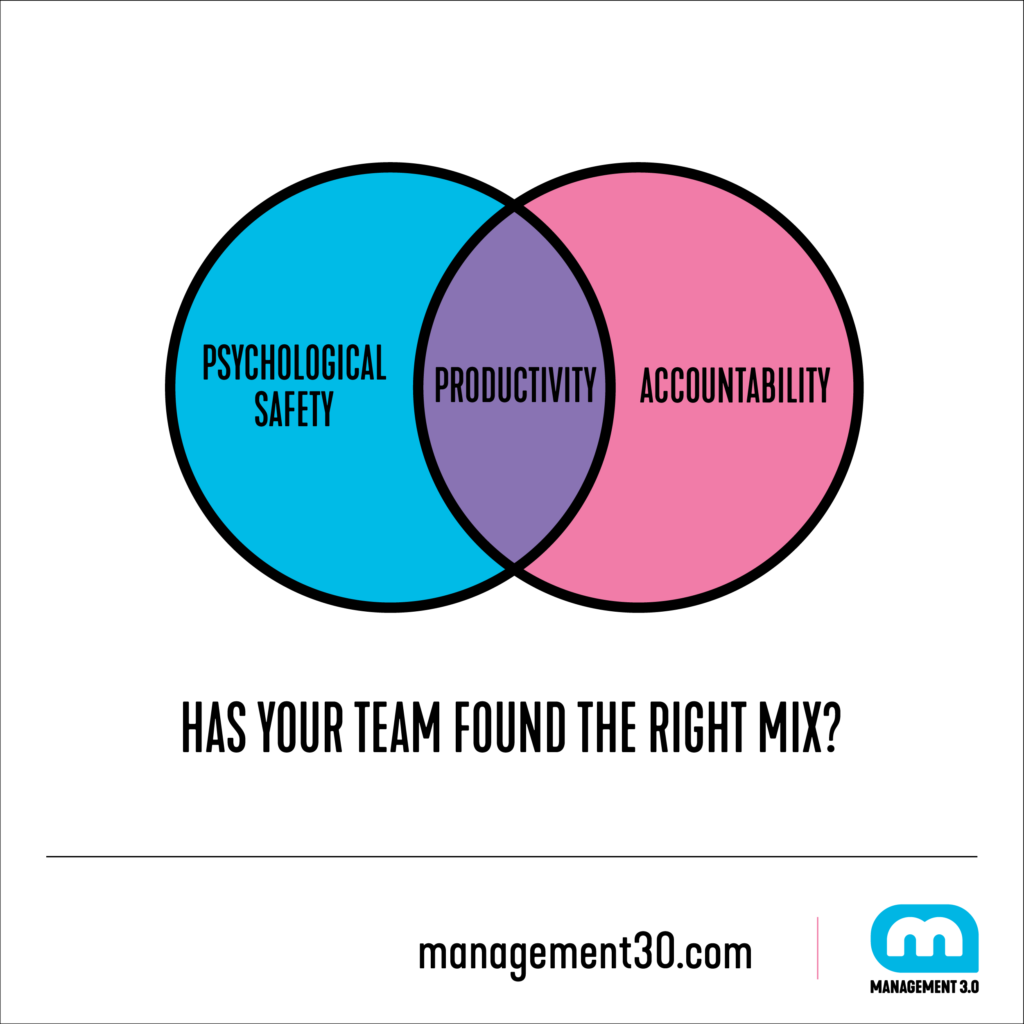Why do some teams outperform others while having the same skills, resources, and structures? Research found, psychological safety is the key element of high-performing teams. An article by André Cruz, Management 3.0 Facilitator and self-called “Culture Hacker” from Brazil, compiling facts around psychological safety and beyond.
Quick links
- What does psychological safety mean?
- Why is psychological safety important?
- Is psychological safety the same as trust?
- Psychological safety vs. accountability
- Psychological safety and learning behavior
- How to build psychological safety?
If you work at a typical organization, you might have asked this very question.
“Why do some teams outperform others while having the same skills, resources, and structures?”
“Talented people” might be the answer that most of us come up with.
In 2012, Google embarked on a big study, code-named Project Aristotle, to discover what made for high performing teams. Google’s top executives long believed that building the best teams meant combining the best people (as I said, most of us think that).
However, after reviewing the academic evidence and data from almost 200 teams, the researchers concluded that “team norms” and, particularly, “psychological safety” were the key drivers of strong team performance.
What does psychological safety mean?
According to Amy Edmondson, a leading researcher on the topic, “psychological safety” is “a belief that no one will be punished or humiliated for sharing ideas, questions, concerns, or mistakes.”
Psychological safety is a belief that no one will be punished or humiliated for sharing ideas, questions, concerns, or mistakes.
Amy Edmondson
She stresses: psychologically safe teams are “characterized by interpersonal trust and mutual respect, in which people are comfortable being themselves”. In such teams, team members feel:
- The environment is safe for interpersonal risk taking
- They are able to speak up when needed
- Colleagues are able to be candid with each other
As per Google researchers, psychological safety “refers to an individual’s perception of the consequences of taking an interpersonal risk or a belief that a team is safe for risk taking in the face of being seen as ignorant, incompetent, negative, or disruptive. In a team with high psychological safety, teammates feel safe to take risks around their team members. They feel confident that no one on the team will embarrass or punish anyone else for admitting a mistake, asking a question, or offering a new idea.”
We are living in times when things like collaboration, autonomy, and self-organizing teams are mandatory for many organizations in order to foster innovation. But how to innovate in an organization where failing is punished or, even worse, where leaders are still imposing their “brilliant” ideas on their teams?
Why is psychological safety important?
In the modern economy, teams and organizations are looking for ideas, innovation, and creativity characteristics that need the adequate system (environment) to spark. Additionally it is essential to attract and retain talent. Here is another question: Can an innovative, creative, and exceptionally talented team achieve their potential if they do not feel safe to speak their minds? Perhaps you can achieve some results in a command and control system with a few lonely geniuses (bosses), however these results are not sustainable.
Ok, not every idea is a killer idea. And yes, there are stupid questions. And yes (again), dissent can slow things down. But talking through these things is an essential part of the creative process.
As Google’s research pointed out, “Taking a risk around your team members may sound simple. But asking a basic question like ‘what’s the goal of this project?’ may make you sound like you’re out of the loop. It might feel easier to continue without getting clarification in order to avoid being perceived as ignorant.”
Taking a risk around your team members may sound simple. But asking a basic question like ‘what’s the goal of this project?’ may make you sound like you’re out of the loop. It might feel easier to continue without getting clarification in order to avoid being perceived as ignorant.
Workplaces where psychological safety is part of the culture and system are constantly enabling innovation while fostering a healthy, creative, happy, and more productive workplace.
In a VUCA / BANI world we need more than ever to decentralize decisions and ideas. We need to give teams autonomy to brainstorm solutions based on the context they are living in. Failing is part of the innovation process and people must feel safe to try new experiments without the fear of losing their jobs, or any other punishment, if things do not work out as they wished.
If organizations keep believing that only leaders are able to generate ideas, or perceive risks and opportunities, they will fall behind the competition. And here is, in my opinion, one of the biggest benefits of having a psychologically safe workplace: People that do not have fear to ask questions, share ideas, or speak up their minds, work as sensors of the organization in a sense that everybody is present to be alert to what is really going on.
Where are the improvements, the innovation, threats, and opportunities? There is no delegation of these questions to executives and leadership. These questions matter to everybody in the system.
Read this article on innovation management.
Is psychological safety the same as trust?
There is indeed a strong link between psychological safety and trust, although they are not the same thing. Trust is a very important component of psychological safety at work. In his book “The Five Dysfunctions of a Team”, Patrick Lencioni points out that trust is “about vulnerability, team members who trust one another learn to be comfortable being open, even exposed, to one another around their failures, weaknesses, even fears.“
The following image demonstrates that based on Lencioni’s five dysfunctions, trust is located at the base of it.
Without trust no one feels safe to be vulnerable, then we will have teams “playing it safe” all the time. There is no discussion or conflict of ideas and everybody in the team looks for social cohesion.
Amazon has something interesting in its culture statement:
“Have a Backbone: Disagree and Commit – leaders are obligated to challenge decisions when they disagree, even when doing so is uncomfortable or exhausting. Leaders have convictions and are tenacious. They do not compromise for the sake of social cohesion. Once a decision is determined, they commit wholly.”
Attitudes like this are possible only when the environment and the system honor these types of statements. For that, trust is essential.
In some cases, executives are afraid that creating a psychologically safe space potentially results in poor team performance: teammates agree with one another for the sake of being nice; they offer unconditional praise and support for everything that is said; and they ultimately excuse themselves from high performance expectations.
However, as we are seeing, the opposite is true: a non-psychologically safe space causes this effect, not the contrary.
Psychological safety vs. accountability
According to the Oxford Dictionary, accountability means “the fact of being responsible for your decisions or actions and expected to explain them when you are asked.” In terms of workplace some definitions vary and can be “holding employees and teams responsible for their decisions, behavior, and actions”.
Once we define what accountability is (or can be) we can try to explain the relation to psychological safety. People to be held accountable for their decisions must be working in a safe place for this. No one will accept being accountable for something, if they are afraid of being punished or judged by their peers when the first wrong decision or action arises.
Then, once again, teams will play safe, when they do that innovation stops. No new business model, no new service, product, or brilliant idea.
In the opinion of Amy Edmondson, these two variables are interdependent. Meaning, to hold people accountable we need to offer a psychologically safe workplace for them. The more demanding the goals are, the higher you need the psychological safety to be. Psychological safety is not a goal by itself, it’s a means to get excellent results.
Psychological safety is not a goal by itself, it’s a means to get excellent results.
Amy Edmondson
Psychological safety and learning behavior
So far, we see that innovation will not happen if people do not find a safe place to ask questions, share ideas, or try new experiments and hypotheses. There is a strong correlation between innovative, psychological safe spaces, and learning organizations.
Amy Edmondson offers this framework to understand where your team might be based on levels of psychological safety, and accountability to meet demanding goals.
If organizations and leaders only care about holding people accountable, but people are not free to express their opinions, ideas, and questions, we would put them in the Anxiety Zone. In this zone, we follow orders and instructions, even when we know that they are wrong.
To reach the Learning Zone which is the high performance zone, organizations and leaders must create a safe environment, especially when we face complexity, uncertainty, and high levels of interdependence. In this zone, people learn and bring the best of themselves to the work.
For a moment imagine a trapeze artist at a circus. If the artist wants to introduce new performances to the show, she is going to need to practice, to experiment with new routines, new techniques, and rehearse. Now imagine doing all this without a safety net. What are the chances she still continues bringing some new performances to the show when an error could be deadly?
Psychological safety works as the net.
So, thinking about your own team, in which quadrant would you place it today? And, if it’s not in the Learning Zone, what could you do to nudge it in that direction?
Additional Resources:
- The Secret to Creating High Performing Teams (Podcast)
- The Key to High-Performing Teams
- Top Five Ways to Create Psychological Safety at Work
- Embracing Psychological Safety (Podcast)
- Creating a psychologically safe space for agile teams (Podcast)
How to build psychological safety?
How do you build up psychologically safe teams that are also high performing? Here are a few suggestions from Amy Edmondson:
- Frame the work as a learning problem not an execution problem by frequently asking your team “what are we learning from this?”
- Acknowledge your own fallibility, encourage your team to tell you what you might be missing.
- Model curiosity by asking lots of questions like: “what worked and didn’t work for you in our collaboration?”
To measure a team’s level of psychological safety, Edmondson asked team members how strongly they agreed or disagreed with these statements:
- If you make a mistake on this team, it is often held against you.
- Members of this team are able to bring up problems and tough issues.
- People on this team sometimes reject others for being different.
- It is safe to take a risk on this team.
- It is difficult to ask other members of this team for help.
- No one on this team would deliberately act in a way that undermines my efforts.
- Working with members of this team, my unique skills and talents are valued and utilized.
You can read Amy Edmondson study and more in her book The Fearless Organization
Google’s Project Aristotle report recommends:
- Solicit input and opinions from the group.
- Share information about personal and work style preferences, and encourage others to do the same.
According to Laura Delizonna, we can create a psychologically safe workplace by:
- Approaching conflict as a collaborator, not an adversary.
- Speaking human to human.
- Anticipating reactions and planning countermoves.
- Replacing blame with curiosity.
- Asking for feedback on delivery.
- Measuring psychological safety.
From the Management 3.0 perspective we can do a lot to create a psychologically safe workplace. Using a gardening metaphor, nurture the soil, then plants can develop by themselves. Creating a safe workplace is part of nurturing the soil.
One point that must be clear: A great team is not just excellent seed (talented people), but excellent seeds and exceptional soil (environment / system).
A great team is not just excellent seed (talented people), but excellent seeds and exceptional soil (environment / system).
Management 3.0 states that: Manage the system, not the people.
Below are a few Management 3.0 modules and practices to foster psychologically safe workplaces:
View: How to Energize People
Module: Motivation and Engagement
People are the most important parts of an organization and managers must do all they can to keep people active, creative, and motivated. Practices like Moving Motivators can help identify intrinsic motivation in a deeper and personal way. Practices to know team members such as Personal Maps can also start to enable trust in the system.
View: How to Empower Teams
Module: Delegation and Empowerment
Teams can self-organize, and this requires empowerment, authorization, and trust from management. Delegation Poker can be a great way to slowly, and comfortably start holding people accountable, and evolve the model as trust and safety increase.
View: How to Align Constraints
Module: Values and Culture
Self-organization can lead to anything, and it’s therefore necessary to protect people and shared resources and to give people a clear purpose and defined goals. Setting OKRs can work as an exercise to invite people to try new objectives and new results and keep people aligned about the strategy, the interdependence between goals and results.
Agile Team Leadership Workshop
Lead and grow self-organized agile teams to high-performing teams – with the
Management 3.0 mindset and tangible tools.










Andre, congratulations for the text. In fact, having a psychologically safe environment is a big challenge. I believe that there are teams that can expose themselves more or less to risks, but in any case, there is always room for a model in which people have more accountability while seeking to reach their maximum potential.
Hi! Roger! Or should I say, hello master!
Thanks for your comment, I must say that you´re a leader that always made room for opinions, ideas and point views, sometimes contrary to yours.
Thanks again!
Above you write:
“Psychological safety” is “a belief that no one will _not_ be punished or humiliated for speaking up with ideas, questions, concerns, or mistakes.”
I believe the double negation here is not intended. By removing the “not” this will be way less funny, but more true to the way I read the rest of this nice text.